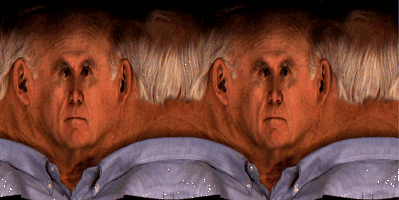

If the reader views the face for a few moments, he/she should notice patches of the image which seem to perceptually organize themselves into a coherent view of part of a head. There is a phenomenal competition between several of these patches, each of which captures a quasi-stable preferred view or pose of the head for that region. Most observers experience only a few stable views (e.g. frontal, three-quarter, profile or back view), even though in principle all views from 0 to 360 degrees are possible. The lack of a visible occluding contour down the mid-line of the face no doubt makes it more difficult to see the profile view near the nose; whereas symmetry seems to contribute to the stability of the frontal view.
This work was done with Nikolaus F. Troje, and Heinrich H. Bülthoff at the Max Planck Institute for Biological Cybernetics in Tübingen, Germany.
Kersten, D., Troje, N. F. &;Bülthoff, H.H. Phenomenal competition for poses of the human head. Perception, 25 (3), 367.
The above figure is Mr. Kersten, senior. Take a look at Richard Gregory's head at the Monthly Perception supplements of the journal Perception.
e-mail: kersten@umn.edu
Return to the Kersten Lab home page
Back to Vision Lab Page
A number of studies suggest that the brain may represent head pose in terms of a discrete set of preferred views. Exactly what these views are, and how their representations enable visual face recognition and pose estimation is not entirely clear. On the one hand, it is easier to find neurons in the primate infero-temporal cortex that are selective for head-on, profile or back views than other angles (Perrett, 1991). On the other hand, psychophysical studies have shown that human face recognition generalizes better from a learned view near 45 deg about the vertical axis than from other views (Troje &;Bülthoff, in press; Bruce &;Valentine, 1987). This latter observation is consistent with theoretical predictions based on virtual views for symmetric objects (Vetter, Poggio &;Bülthoff, 1993). In either case, one might expect that if an image of a human head is presented in such a way as to make pose assignment ambiguous, we might visually experience a competition for preferred poses as is suggested from introspection of the above figure.
It is conceivable that neurons tuned to particular poses of the head (Perrett et al., 1991) enhance the perception of stable views. Of course, we are able to recognize a person from non-preferred views under normal conditions. Logothetis et al. (1994) discuss an interpolation network for recognition based on tuned neurons. In a multistable display, however, these interpolated views cannot compete with the "tuned views".
Bruce, V. & Valentine, T. (1987) The basis of the 3/4 view advantage in face recognition. Applied Cognitive Psychology. 1, 109-120.
Logothetis, N. K., Pauls J., Bülthoff, H.H. and Poggio, T. (1994), View-dependent object recognition by monkeys, Current Biology 4, 401-414.
Perrett, D. I., Oram, M.W., Harries M. H., Bevan R., Benson P. J. & Thomas S. (1991) Viewer centered and object centered coding of heads in the macaque temporal cortex. Experimental Brain Research, 86, 159-173.
Troje, N. F. & Bülthoff H. B. (in press) Face recognition under varying pose: The role of texture and shape. Vision Research.
Vetter, T., Poggio, T. & Bülthoff, H. (1993). 3D object recognition: Symmetry and virtual views. Current Biology, 4, 18-23.